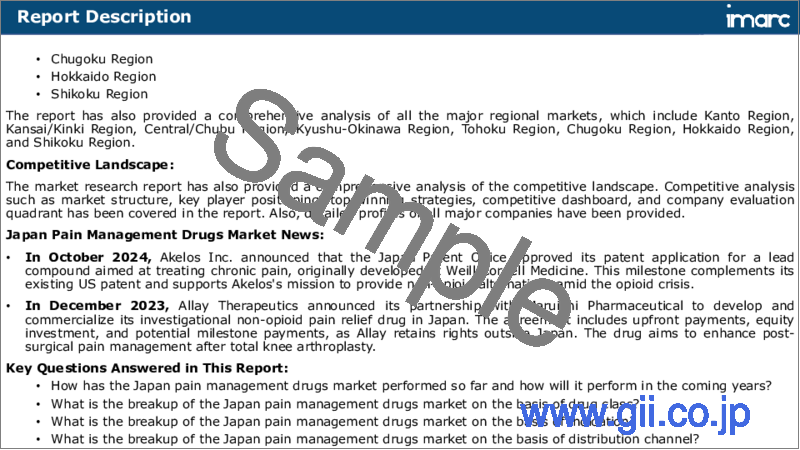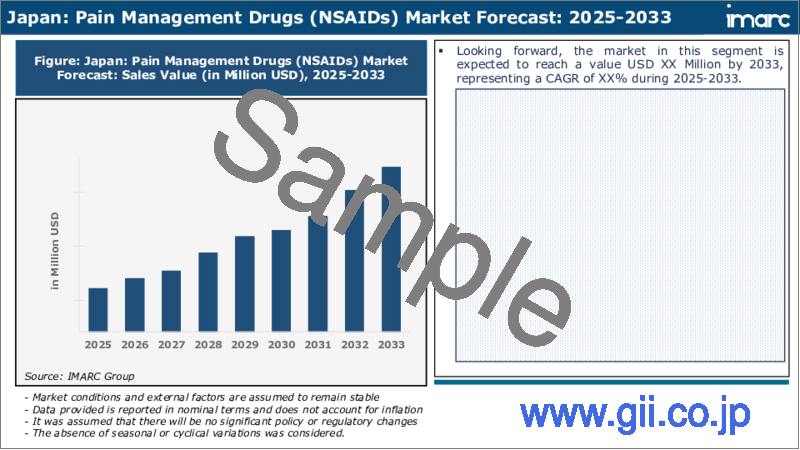|
|
市場調査レポート
商品コード
1747115
日本の疼痛管理薬市場規模、シェア、動向、予測:薬剤クラス別、適応症別、流通チャネル別、地域別、2025~2033年Japan Pain Management Drugs Market Size, Share, Trends and Forecast by Drug Class, Indication, Distribution Channel, and Region, 2025-2033 |
||||||
カスタマイズ可能
|
|||||||
| 日本の疼痛管理薬市場規模、シェア、動向、予測:薬剤クラス別、適応症別、流通チャネル別、地域別、2025~2033年 |
|
出版日: 2025年06月02日
発行: IMARC
ページ情報: 英文 116 Pages
納期: 5~7営業日
|
全表示
- 概要
- 目次
日本の疼痛管理薬市場規模は2024年に42億2,267万米ドルに達しました。今後、IMARC Groupは、2033年に市場は52億448万米ドルに達し、2025~2033年の成長率(CAGR)は2.35%になると予測しています。高齢化、ドラッグデリバリーの技術革新、非オピオイド治療に対する需要の高まりが市場の大きな成長をもたらしています。さらに、厳しい規制とヘルスケア改革が、全国的な市場拡大と治療法の進歩を形成し続けています。
本レポートで扱う主要質問
- 日本の疼痛管理薬市場はこれまでどのように推移し、今後どのように推移するのか?
- 日本の疼痛管理薬市場の薬剤クラス別区分は?
- 日本の疼痛管理薬市場の適応症別区分は?
- 日本の疼痛管理薬市場の流通チャネル別区分は?
- 日本の疼痛管理薬市場の地域別区分は?
- 日本の疼痛管理薬市場のバリューチェーンにおける様々なステージとは?
- 日本の疼痛管理薬市場の主要促進要因と課題は?
- 日本の疼痛管理薬市場の構造と主要参入企業は?
- 日本の疼痛管理薬市場の競合状況は?
目次
第1章 序文
第2章 調査範囲と調査手法
- 調査の目的
- ステークホルダー
- データソース
- 市場推定
- 調査手法
第3章 エグゼクティブサマリー
第4章 日本の疼痛管理薬市場-イントロダクション
- 概要
- 市場力学
- 産業動向
- 競合情報
第5章 日本の疼痛管理薬市場情勢
- 過去と現在の市場動向(2019~2024年)
- 市場予測(2025~2033年)
第6章 日本の疼痛管理薬市場-薬剤クラス別内訳
- NSAIDs
- 麻酔薬
- 抗けいれん薬
- 抗片頭痛薬
- 抗うつ薬
- オピオイド
- その他
第7章 日本の疼痛管理薬市場-適応症別内訳
- 筋骨格系の痛み
- 手術と外傷の痛み
- がんの痛み
- 神経障害性疼痛
- 片頭痛の痛み
- 産科痛
- 線維筋痛症の痛み
- 火傷の痛み
- 歯/顔の痛み
- 小児の痛み
- その他
第8章 日本の疼痛管理薬市場-流通チャネル別内訳
- 病院薬局
- 小売薬局
- オンライン薬局
第9章 日本の疼痛管理薬市場-競合情勢
- 概要
- 市場構造
- 市場企業のポジショニング
- 主要成功戦略
- 競合ダッシュボード
- 企業評価象限
第10章 主要企業のプロファイル
第11章 日本の疼痛管理薬市場-産業分析
- 促進要因・抑制要因・機会
- ポーターのファイブフォース分析
- バリューチェーン分析
第12章 付録
The Japan pain management drugs market size reached USD 4,222.67 Million in 2024. Looking forward, IMARC Group expects the market to reach USD 5,204.48 Million by 2033, exhibiting a growth rate (CAGR) of 2.35% during 2025-2033. The market is experiencing significant growth, driven by an aging population, innovation in drug delivery, and rising demand for non-opioid treatments. Moreover, strict regulations and healthcare reforms continue to shape market expansion and therapeutic advancements nationwide.
Japan Pain Management Drugs Market Trends:
Rising Geriatric Population
Japan's aging population is a significant driver of sustained demand in the pain management drugs industry. The increasing number of elderly individuals is directly influencing Japan pain management drugs market growth, as age-related health issues such as osteoarthritis, chronic back pain, and neuropathic conditions become more prevalent. According to the reports, Japan's elderly population reached a record 36.25 million, making up 29.3% of the total population. Women aged 65 or older account for 20.53 million, while men total 15.72 million. Additionally, 9.14 million elderly are employed, reflecting ongoing demographic challenges as the population declines for the 13th consecutive year. With life expectancy among the highest globally, a large segment of the population requires long-term, consistent pain relief therapies. These often include a combination of NSAIDs, antidepressants, and specialized treatments tailored to older adults, who are also more vulnerable to drug sensitivity and side effects. Healthcare providers are adapting by prioritizing safer, lower-dose formulations and monitoring protocols. Additionally, the rising rate of age-related surgeries, such as joint replacements, is fueling demand for post-operative pain medications. As Japan's demographic shift deepens, this trend will continue to increase the Japan pain management drugs market share across therapeutic categories.
Innovation in Drug Delivery and Formulation
Japanese pharmaceutical companies are actively innovating drug delivery methods to improve treatment outcomes and enhance patient comfort. With a growing focus on chronic pain and elderly care, firms are shifting toward advanced options such as transdermal patches, extended-release tablets, and topical gels or sprays. These alternatives allow for more precise dosing, sustained pain relief, and reduced gastrointestinal or systemic side effects, which are particularly important for older adults and long-term users. Innovation in formulation also includes development of combination drugs and novel compounds that target pain more efficiently while reducing dependency risks. For instance, in November 2024, Eisai Co., Ltd. launched Rozebalamin(R) for Injection 25 mg (mecobalamin) in Japan, to slow functional impairment and address pain in amyotrophic lateral sclerosis (ALS) patients. Approved in September, it follows a Phase III trial with 130 patients. These advancements are not only improving adherence but also expanding product offerings across therapeutic categories. As regulatory bodies support safer alternatives and healthcare professionals adopt newer delivery formats, innovation is expected to play a key role in shaping the Japan pain management drugs market outlook in the coming years.
Japan Pain Management Drugs Market Segmentation:
Drug Class Insights:
- NSAIDs
- Anesthetics
- Anticonvulsants
- Antimigraine Agents
- Antidepressants
- Opioids
- Others
Indication Insights:
- Musculoskeletal Pain
- Surgical and Trauma Pain
- Cancer Pain
- Neuropathic Pain
- Migraine Pain
- Obstetrical Pain
- Fibromyalgia Pain
- Burn Pain
- Dental/Facial Pain
- Pediatric Pain
- Others
Distribution Channel Insights:
- Hospital Pharmacies
- Retail Pharmacies
- Online Pharmacies
Competitive Landscape:
The market research report has also provided a comprehensive analysis of the competitive landscape. Competitive analysis such as market structure, key player positioning, top winning strategies, competitive dashboard, and company evaluation quadrant has been covered in the report. Also, detailed profiles of all major companies have been provided.
Key Questions Answered in This Report:
- How has the Japan pain management drugs market performed so far and how will it perform in the coming years?
- What is the breakup of the Japan pain management drugs market on the basis of drug class?
- What is the breakup of the Japan pain management drugs market on the basis of indication?
- What is the breakup of the Japan pain management drugs market on the basis of distribution channel?
- What is the breakup of the Japan pain management drugs market on the basis of region?
- What are the various stages in the value chain of the Japan pain management drugs market?
- What are the key driving factors and challenges in the Japan pain management drugs market?
- What is the structure of the Japan pain management drugs market and who are the key players?
- What is the degree of competition in the Japan pain management drugs market?
Table of Contents
1 Preface
2 Scope and Methodology
- 2.1 Objectives of the Study
- 2.2 Stakeholders
- 2.3 Data Sources
- 2.3.1 Primary Sources
- 2.3.2 Secondary Sources
- 2.4 Market Estimation
- 2.4.1 Bottom-Up Approach
- 2.4.2 Top-Down Approach
- 2.5 Forecasting Methodology
3 Executive Summary
4 Japan Pain Management Drugs Market - Introduction
- 4.1 Overview
- 4.2 Market Dynamics
- 4.3 Industry Trends
- 4.4 Competitive Intelligence
5 Japan Pain Management Drugs Market Landscape
- 5.1 Historical and Current Market Trends (2019-2024)
- 5.2 Market Forecast (2025-2033)
6 Japan Pain Management Drugs Market - Breakup by Drug Class
- 6.1 NSAIDs
- 6.1.1 Overview
- 6.1.2 Historical and Current Market Trends (2019-2024)
- 6.1.3 Market Forecast (2025-2033)
- 6.2 Anesthetics
- 6.2.1 Overview
- 6.2.2 Historical and Current Market Trends (2019-2024)
- 6.2.3 Market Forecast (2025-2033)
- 6.3 Anticonvulsants
- 6.3.1 Overview
- 6.3.2 Historical and Current Market Trends (2019-2024)
- 6.3.3 Market Forecast (2025-2033)
- 6.4 Antimigraine Agents
- 6.4.1 Overview
- 6.4.2 Historical and Current Market Trends (2019-2024)
- 6.4.3 Market Forecast (2025-2033)
- 6.5 Antidepressants
- 6.5.1 Overview
- 6.5.2 Historical and Current Market Trends (2019-2024)
- 6.5.3 Market Forecast (2025-2033)
- 6.6 Opioids
- 6.6.1 Overview
- 6.6.2 Historical and Current Market Trends (2019-2024)
- 6.6.3 Market Forecast (2025-2033)
- 6.7 Others
- 6.7.1 Historical and Current Market Trends (2019-2024)
- 6.7.2 Market Forecast (2025-2033)
7 Japan Pain Management Drugs Market - Breakup by Indication
- 7.1 Musculoskeletal Pain
- 7.1.1 Overview
- 7.1.2 Historical and Current Market Trends (2019-2024)
- 7.1.3 Market Forecast (2025-2033)
- 7.2 Surgical and Trauma Pain
- 7.2.1 Overview
- 7.2.2 Historical and Current Market Trends (2019-2024)
- 7.2.3 Market Forecast (2025-2033)
- 7.3 Cancer Pain
- 7.3.1 Overview
- 7.3.2 Historical and Current Market Trends (2019-2024)
- 7.3.3 Market Forecast (2025-2033)
- 7.4 Neuropathic Pain
- 7.4.1 Overview
- 7.4.2 Historical and Current Market Trends (2019-2024)
- 7.4.3 Market Forecast (2025-2033)
- 7.5 Migraine Pain
- 7.5.1 Overview
- 7.5.2 Historical and Current Market Trends (2019-2024)
- 7.5.3 Market Forecast (2025-2033)
- 7.6 Obstetrical Pain
- 7.6.1 Overview
- 7.6.2 Historical and Current Market Trends (2019-2024)
- 7.6.3 Market Forecast (2025-2033)
- 7.7 Fibromyalgia Pain
- 7.7.1 Overview
- 7.7.2 Historical and Current Market Trends (2019-2024)
- 7.7.3 Market Forecast (2025-2033)
- 7.8 Burn Pain
- 7.8.1 Overview
- 7.8.2 Historical and Current Market Trends (2019-2024)
- 7.8.3 Market Forecast (2025-2033)
- 7.9 Dental/Facial Pain
- 7.9.1 Overview
- 7.9.2 Historical and Current Market Trends (2019-2024)
- 7.9.3 Market Forecast (2025-2033)
- 7.10 Pediatric Pain
- 7.10.1 Overview
- 7.10.2 Historical and Current Market Trends (2019-2024)
- 7.10.3 Market Forecast (2025-2033)
- 7.11 Others
- 7.11.1 Historical and Current Market Trends (2019-2024)
- 7.11.2 Market Forecast (2025-2033)
8 Japan Pain Management Drugs Market - Breakup by Distribution Channel
- 8.1 Hospital Pharmacies
- 8.1.1 Overview
- 8.1.2 Historical and Current Market Trends (2019-2024)
- 8.1.3 Market Forecast (2025-2033)
- 8.2 Retail Pharmacies
- 8.2.1 Overview
- 8.2.2 Historical and Current Market Trends (2019-2024)
- 8.2.3 Market Forecast (2025-2033)
- 8.3 Online Pharmacies
- 8.3.1 Overview
- 8.3.2 Historical and Current Market Trends (2019-2024)
- 8.3.3 Market Forecast (2025-2033)
9 Pediatric Pain
- 7.9.1 Overview
- 7.9.2 Historical and Current Market Trends (2019-2024)
- 7.9.3 Market Forecast (2025-2033)
- 7.10 Others
- 7.10.1 Historical and Current Market Trends (2019-2024)
- 7.10.2 Market Forecast (2025-2033)
8 Japan Pain Management Drugs Market - Breakup by Distribution Channel
- 8.1 Hospital Pharmacies
- 8.1.1 Overview
- 8.1.2 Historical and Current Market Trends (2019-2024)
- 8.1.3 Market Forecast (2025-2033)
- 8.2 Retail Pharmacies
- 8.2.1 Overview
- 8.2.2 Historical and Current Market Trends (2019-2024)
- 8.2.3 Market Forecast (2025-2033)
- 8.3 Online Pharmacies
- 8.3.1 Overview
- 8.3.2 Historical and Current Market Trends (2019-2024)
- 8.3.3 Market Forecast (2025-2033)
9 Japan Pain Management Drugs Market - Competitive Landscape
- 9.1 Overview
- 9.2 Market Structure
- 9.3 Market Player Positioning
- 9.4 Top Winning Strategies
- 9.5 Competitive Dashboard
- 9.6 Company Evaluation Quadrant
10 Profiles of Key Players
- 10.1 Company A
- 10.1.1 Business Overview
- 10.1.2 Products Offered
- 10.1.3 Business Strategies
- 10.1.4 SWOT Analysis
- 10.1.5 Major News and Events
- 10.2 Company B
- 10.2.1 Business Overview
- 10.2.2 Products Offered
- 10.2.3 Business Strategies
- 10.2.4 SWOT Analysis
- 10.2.5 Major News and Events
- 10.3 Company C
- 10.3.1 Business Overview
- 10.3.2 Products Offered
- 10.3.3 Business Strategies
- 10.3.4 SWOT Analysis
- 10.3.5 Major News and Events
- 10.4 Company D
- 10.4.1 Business Overview
- 10.4.2 Products Offered
- 10.4.3 Business Strategies
- 10.4.4 SWOT Analysis
- 10.4.5 Major News and Events
- 10.5 Company E
- 10.5.1 Business Overview
- 10.5.2 Products Offered
- 10.5.3 Business Strategies
- 10.5.4 SWOT Analysis
- 10.5.5 Major News and Events
11 Japan Pain Management Drugs Market - Industry Analysis
- 11.1 Drivers, Restraints, and Opportunities
- 11.1.1 Overview
- 11.1.2 Drivers
- 11.1.3 Restraints
- 11.1.4 Opportunities
- 11.2 Porters Five Forces Analysis
- 11.2.1 Overview
- 11.2.2 Bargaining Power of Buyers
- 11.2.3 Bargaining Power of Suppliers
- 11.2.4 Degree of Competition
- 11.2.5 Threat of New Entrants
- 11.2.6 Threat of Substitutes
- 11.3 Value Chain Analysis





